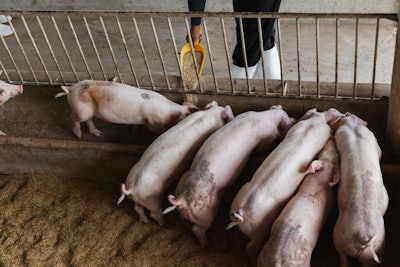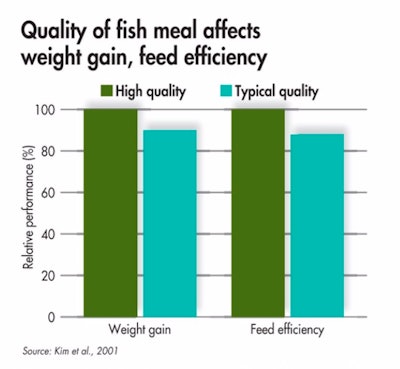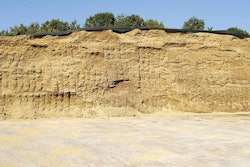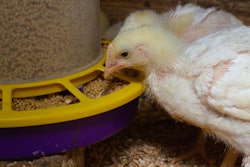
There are fresh ideas why fish meal should be considered again as an ingredient for modern piglet diets.
Long before specialty ingredients and additives were discovered, piglet feeds were simple affairs based on corn and soybean meal, fortified with milk products (mostly whey) and fish meal. Whey was important for feed intake, but fish meal made a real difference not only as a tasty ingredient, but also as a source of highly digestible proteins.
Feeds contained up to 10% fish meal as piglets often refused feed with more than 1% fish oil; and most fish meals contained about 10% fish oil, so the math gives 1% oil more or less. With increasing piglet weight, fish meal inclusion was reduced, but even in the later stages of the nursery period, some high-quality feeds contained 2.5% fish meal. A typical three-phase nursery program, thus, might contain 10%, 7.5%, and 2.5% fish meal; the numbers picked in a way to accommodate the typical weight of a bag of fish meal, 25 kg. But, back then, good quality fish meal was about US$500-600 per ton as the price jumped first to US$1,000 and even ended up, less than 10 years ago, to exceed US$2,000 per ton. Prices today for high-quality fish meal are about US$1,500 per ton, which are still too high.
Removal from piglet diets
Fish meal was then removed from most piglet formulas. First, because it became too expensive – the reason being the diminishing fishing activities to preserve natural fish stock and the high demand for aqua feeds. Second, animal plasma was discovered and required a huge chunk of the available formulation cost in order to be effective. With comparable inclusion levels, animal plasma was and remains about double the price of fish meal. As results were deemed better when animal plasma was included, fish meal became the only source of available cost to cover the new expense. Having both in the same formula was virtually impossible for cost reasons, whereas many nutritionists even questioned the need as animal plasma feeds seemed to perform well without fish meal. I am not sure if anyone even thought of using less animal plasma in a high fish meal diet, say in a factorial design.
Today, using animal plasma is no longer a no-questions-asked practice. Its value in terms of animal performance is unquestionable, but other issues, along with an increasing price, have created a schism among nutritionists. Some use it as always, or prefer to use a variation of it, like bovine-only source plasma. Others, then, have abandoned it completely, either for alternative sources of immunoglobulins and whatever else in animal plasma that makes it what it is, or have gone back to more traditional formulas. If feed intake and consequently growth performance (or, is it vice versa?) suffer a bit, this is not considered as too bad if the feed is not super expensive. After all, a high feed intake coupled with below par health status is a success recipe for diarrheas, especially now that antibiotics and soon zinc oxide will be banned everywhere, eventually.
Old idea new again?
Not long ago, I received a request from a party interested to consult for them regarding the possibility of using fish meal in piglet diets. They considered piglet feeds as a good target group for their products as they noticed the piglet feed industry is not using this ingredient. They were really surprised when I just pointed them to old textbooks indicating that fish meal was once considered a must for all piglet feeds. Eventually, they buckled at the whole idea as the proposal to re-educate nutritionists was beyond their needs. Apparently, they thought they had discovered another novel ingredient that they could sell as an additive and they cooled off when they realized they had in their hands an old but valuable staple ingredient.
Today, nutritionists around the world also have positions regarding fish meal. The younger generations do not really know how to use it, let alone distinguish between good quality and medium- or poor-quality products. And, in the case of fish meal, quality plays a major role (see Figure 1). As such, they prefer to use other, more convenient protein sources, mostly of vegetable origin. This goes well with the even newer trend of making omnivorous animals eat vegetarian diets, so perhaps this is the right way to the future. Older nutritionists who had significant experiences with fish meal and see how modern piglet feeds have ended up (basically devoid of high-quality materials and full of marketing products) are ready to use it, but they have no money to spend on it. They dare not remove any of the marketing products either because they do not know how or out of fear of market backlash, but they know they use more than they should.
 Figure 1: Quality plays a major role in the case of fish meal.
Figure 1: Quality plays a major role in the case of fish meal.Room to bring back fish meal
There is some formulation cost to spare, if one is knowledgeable and brave enough, in order to make room to bring in some high-quality fish meal. Doing so for poor products will only make matters worse, so low-price singing sirens should be faced with a deaf ear. Of course, it remains impossible to go back to 10% fish meal, unless one adjusts other expensive ingredients too, but adding something like 2.5% may make a huge difference in some formulas. As always, results depend on the original-base formula design, so this is not a blanket recommendation, but rather a call for investigation.
Another reason to bring back some fish meal is its high concentration in omega-3 fatty acids, especially those impossible to find in plants, such as EPA and DHA. Recent evidence indicates that these omega-3 fatty acids have beneficial effects on piglet health and performance, although research remains still in its infancy. Although linseed is another excellent source of omega-3 fatty acids, namely ALA, the conversion to EPA and DHA is no more than 20% and it is the latter two that are needed in order to boost the immune system and reduce inflammatory conditions. Incidentally, another good research project would be to investigate the use of omega-3 fatty acids as an anti-inflammatory additive along with high soybean meal levels known to cause allergenic reactions in the gut that are manifested as inflammation.
So, fish meal is neither a novel nor a dead ingredient. It just needs to find a new place in modern piglet feeds to rebalance quality with marketing and bring in some new concepts that could even pay for the extra cost.

















